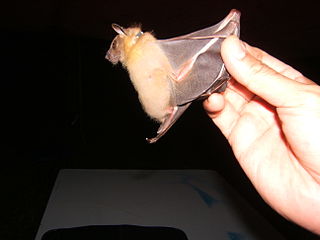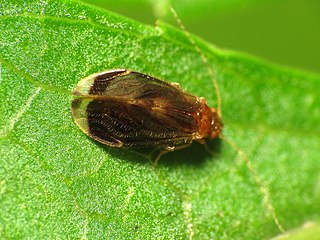
Coprinus is a small genus of mushroom-forming fungi consisting of Coprinus comatus—the shaggy ink cap (British) or shaggy mane (American)—and several of its close relatives. Until 2001, Coprinus was a large genus consisting of all agaric species in which the lamellae autodigested to release their spores. The black ink-like liquid this creates gave these species their common name "ink cap" (British) or "inky cap" (American).

Emballonuridae is a family of microbats, many of which are referred to as sac-winged or sheath-tailed bats. They are widely distributed in tropical and subtropical regions around the world. The earliest fossil records are from the Eocene.

Cynopterus is a genus of megabats. The cynopterine section is represented by 11 genera, five of which occur in Malaysia, namely, Chironax, Balionycteris, Penthetor, Dyacopterus, and Cynopterus. About 30 names for Cynopterus species have been proposed, but only 16 are taxonomically valid forms.

The shaggy bat is a bat species from South America. It appears to be a slow flier and has a rather regular pattern of foraging in its home range, a feature shared with other emballonurids. It is also aerial insectivore.

Carollia is a genus of bats often referred to as the short-tailed fruit bats. Along with the genus Rhinophylla, Carollia makes up the subfamily Carolliinae of family Phyllostomidae, the leaf-nosed bats. Currently, nine species of Carollia are recognized, with a number having been described since 2002. Members of this genus are found throughout tropical regions of Central and South America but do not occur on Caribbean islands other than Trinidad and Tobago. Bats of the genus Carollia often are among the most abundant mammals in neotropical ecosystems and play important roles as seed dispersers, particularly of pioneer plants such as those of the genera Piper, Cecropia, Solanum, and Vismia. Carollia are primarily frugivorous; however, C. perspicillata, C. castanea, and C. subrufa are known to feed on insects.

The genus Corynorhinus consists of the big-eared bats, or American long-eared bats. Only three species occur in the genus, all occurring in North America. Members of this group were previously in the genus Plecotus, the long-eared bats, and were also then called lump-nosed bats. Populations of these species are generally uncommon and declining. Two subspecies, the Virginia big-eared bat and the Ozark big-eared bat are federally endangered.

The eastern red bat is a species of microbat in the family Vespertilionidae. Eastern red bats are widespread across eastern North America, with additional records in Bermuda.
The eastern false pipistrelle is a vespertilionid bat that occurs in eastern and south-eastern Australia, including the island of Tasmania.
The West African shaggy rat is a species of rodent in the family Muridae. It is found in Benin, Cameroon, Ivory Coast, Gambia, Ghana, Guinea, Guinea-Bissau, Liberia, Mali, Nigeria, Senegal, Sierra Leone, and Togo. Its natural habitats are subtropical or tropical seasonally wet or flooded lowland grassland and swamps. It is a common species and the International Union for Conservation of Nature has rated its conservation status as being of "least concern".

Taphozous is a genus of the family Emballonuridae. The wide distribution of the genus includes several regions of Australia, Indonesia, Papua New Guinea and Africa. Taphozous comes from the Greek τάφος, meaning "a tomb". The common names for species include variants on sac-winged, sheathtail, or tomb bats.

Caeciliusetae is an infraorder of Psocodea in the suborder Psocomorpha. There are about 6 families and more than 1,300 described species in Caeciliusetae.

Laephotis is a genus of bats in the family Vespertilionidae. Species within this genus are:

The Thomas's shaggy bat is a bat species from South America. It was previously included in the shaggy bat but Simmons and Handley (1998) showed that the species were distinct.

Thomas's fruit-eating bat, sometimes also popularly called Watson's fruit-eating bat, is a species of bat in the family Phyllostomidae. It is found from southern Mexico, through Central America to Colombia. Its South American range is to the west of the Andes. The species name is in honor of H. J. Watson, a plantation owner in western Panama who used to send specimens to the British Natural History Museum, where Oldfield Thomas would often describe them.

Bats are mammals of the order Chiroptera. With their forelimbs adapted as wings, they are the only mammals capable of true and sustained flight. Bats are more agile in flight than most birds, flying with their very long spread-out digits covered with a thin membrane or patagium. The smallest bat, and arguably the smallest extant mammal, is Kitti's hog-nosed bat, which is 29–34 millimetres in length, 150 mm (6 in) across the wings and 2–2.6 g in mass. The largest bats are the flying foxes, with the giant golden-crowned flying fox, Acerodon jubatus, reaching a weight of 1.6 kg and having a wingspan of 1.7 m.

Cynomops is a genus of Central and South American dog-faced bats in the family Molossidae. It has sometimes been considered a subgenus of Molossops. It contains the following species:
Glover Allen's dasymys is a species of shaggy marsh rat described in 1953, and indigenous to Mount Rungwe in south-western Tanzania. Contemporary studies of the taxonomy diverge, with the International Union for Conservation of Nature recognising D. alleni as a subspecies of the more widespread D. incomtus, whereas Wilson and Reeder observe the reinstatement of the species as unique in Mammal Species of the World. In their recent analysis, Verheyen et al. describe the distribution of D. alleni as encompassing the Eastern Arc Mountains and the mountainous, volcanic regions around Lake Tanganyika, and potentially the Marungu highlands, in the Democratic Republic of the Congo.
The Cuban yellow bat is a species of bat from the family Vespertilioninae. It was previously included as a subspecies of the northern yellow bat, a species that has a similar ecology and biology. The species is endemic to Cuba, specifically the Las Villas Province in Cienfuegos, and it is listed under the IUCN Red List as vulnerable due to its ongoing population reduction and relatively small geographic range.
The Taiwan broad-muzzled bat or Taiwan broad-muzzled myotis is a species of vesper bat found in Taiwan.














